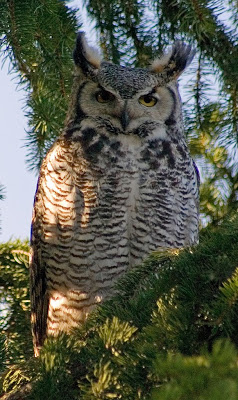Except for the snowy owl which is primarily found in the treeless tundra, nearly all owl species make habitats in forest habitats. Great horned owl—one of the biggest of the North American owls stretches its range from the stunted pine trees of Central America and Florida to the secondary-growth woodlands of the north. These owls are known to make homes in a wide variety of habitats because they have an extensive diet range. However, this article is all about great horned owl habitat; essential characteristics, and habitat requirements.
Where Do Great Horned Owls Live – Great Horned Owl Habitat

Great horned owls predominantly occur throughout the North American tree line and its habitat includes woodlands, agricultural areas, tropical rainforests, mountainous areas, mangrove swamp forests, rocky coasts, saltwater marshes, freshwater marshes, mesquite, semi-arid grasslands, cacti deserts, deciduous, mixed and coniferous forests.
They likely fancy living in habitats which are dominated by old-growth trees. Previously they were thought to occur only in interior forests however as scientists studied more they found out that great horned owls were actually widespread in woodlands and mosaic of fields in the temperate habitats.
Great horned owls are less likely to breed in tall grasslands, shrub-steppe communities, pygmy woodlands, desert, and chaparral.
Scientists have recognized more than ten subspecies of great horned owls some of which prefer inhabiting open habitats including croplands, cliffs, wetlands, and juniper. Many individuals likely live in suburban areas and cities. Great horned owls typically choose dense forests for roosting as well as nesting to seek protection from predators even though they’ve got only a few predators. In Colorado, hoot owls share their homes with long-eared owls and barn owls.
While they are found in rocky areas great horned owls may not choose to live in the middle of the desert or a treeless tundra—a snowy owl’s habitat. Studies suggest that great horned owl selects forest that has at least 70% of old-growth trees. They just don’t like to live in Amazon rainforests. The permanent habitats are grasslands and prairies particularly those that consists of rocky canyon and shaded trees.

Altitude of a Great Horned Owl Habitat
The Californian population of a great horned owl is found at an elevation of 6,900 feet but those that live in Rockies make habitat at a height of 10,800 feet. All these species fancy choosing mountainous habitats. Similarly, the highest population of great horned owls is found at a height of 13,500 to 14,800 feet above the sea level in Peru.
Great horned owls do not really like to live in suburban areas although they do feel home at public parks. They typically prefer wooded habitats one that is away from human population. Screech owls are known to roost in urban areas.
Great Horned Owl Distribution and Range
Great horned owls occupy much of the North America and their range largely includes Ontario, Pricne Edward Island, Okak, Mackenzie Mountains, Keewatin, northern Manitoba, Newfoundland, and Labrador.
Although not in large numbers, great horned owls do occur in South and Central America such as Bolivia, Peru, and Argentina. They are not found in the northwestern South America. The South American population is mainly found in the mangrove forests.
Where Do Great Horned Owls Live Map and Video

References
Stiles, F. G. and A. F. Skutch. 1989. A guide to the birds of Costa Rica. Comstock Publishing Associates, Cornell University Press, Ithaca, NY.
König, Claus; Weick, Friedhelm (2008). Owls of the World (2nd ed.). London: Christopher Helm. ISBN 9781408108840.
Smith, D. G. and J. R. Murphy. 1982. Nest site selection in raptor communities of the Eastern Great Basin Desert. Great Basin Naturalist, 42:395-404.
Root, T. 1988. Atlas of wintering North American birds: an analysis of Christmas bird count data. University of Chicago Press, Chicago.
Rohner, C. and C. J. Krebs. 1996. Owl predation on snowshoe hares: consequences of antipredator behaviour. Oecologia 198:303-310.
Franks, E.C. & Warnock, J.E. 1969. Great Horned Owl nesting in populated area. Wilson Bulletin, 81 (3): 332-333.
Mcgarigal, K. and J. D. Fraser. 1984. The effect of forest stand age on owl distribution in southwestern Virginia. Journal of Wildlife Management, 48:1393-1398.












